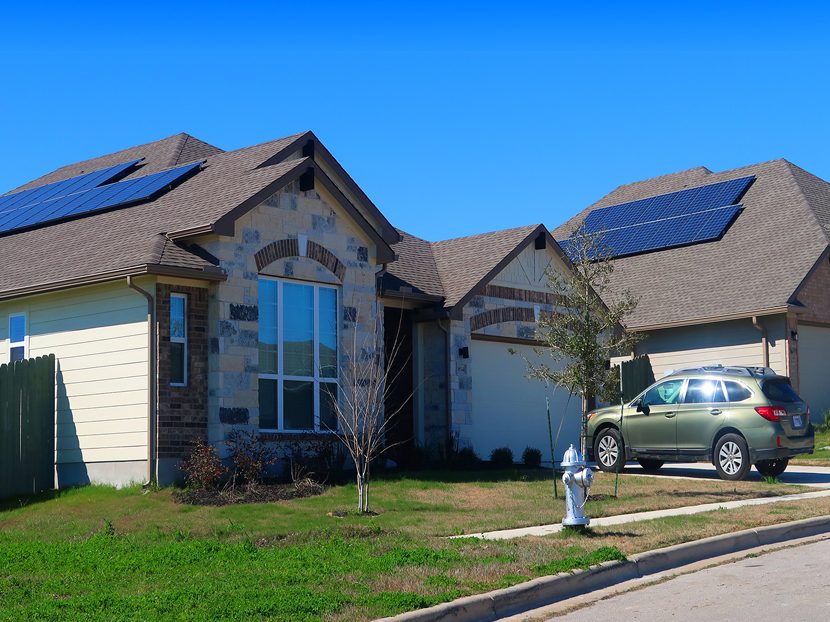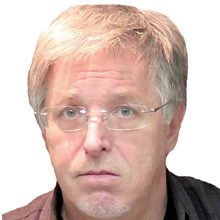America’s Clean Energy Secret
Texas’ Whisper Valley is a living laboratory to help progressive companies plan production-scale housing projects for a different kind of world.

Pssst! Want to know a secret? It’s not going to be that hard to construct clean energy homes at scale.
On topics such as clean-running buildings, the mainstream media does some speculating, and so do some who comment on economics. I keep reading that shifting to clean energy in buildings will cost us a fortune.
Meanwhile, almost every day, I talk with people who are working on them and they tell me the opposite. It already costs the same or a little more to build proper buildings, and a lot less to operate them. This seems to be unknown, but it shouldn’t be.
A perfect illustration of America’s clean energy secret is a new 7,500-home development in Austin, Texas, appropriately called Whisper Valley. Despite the name working great for my secret theme here, the developers of this project are not hiding their success. They want to shout it from their solar-adorned rooftops.
The reason they are excited is that they’ve solved the challenges facing those who want to take clean energy from small pilot projects to large-production building. At Whisper Valley, there are five different builders involved and they’re not small players. As we know, creating a package that makes clean energy work for almost any builder has been seen as a challenge for some time.
But at Whisper Valley, such difficulties are a thing of the past. And their model is resulting in the homes of the future.
7,500 Homes, Five Builders
Whisper Valley is a $2 billion, 15-year project on 2,000 acres of rolling suburban land, adding hundreds of homes each year. All its high-tech and green systems are being monitored, with data collected and analyzed continuously, providing valuable lessons learned for the planning of tomorrow’s ultra-efficient master-planned communities.
Not only are builders finding it simple to connect to the project’s geothermal cooling (and heating) system, but they are finding it easy to sell the clean, green homes to Texans and, in some cases, to people who are moving from out of state because they’ve heard about them.
“One of the most important decisions we’ve made was to embrace this technology and aligned ourselves with people who knew how to work with it,” says Doug Gilliland, president of developer Taurus of Texas, and managing partner of Whisper Valley. “And they’re bringing it to the market in a mass-production way … These are the DR Horton’s of the world.” (Horton promotes itself as “America’s largest homebuilder,” operating in 43 states; it has completed 740,000 homes).
He adds: “Bringing this kind of lifestyle to the mainstream buying market is possible. In the past, this type of living opportunity was only available to the more affluent home purchasers on a custom basis. That’s the opposite of what we’re doing. We’re bringing it to people who are buying their first or second home and working with builders who are value-oriented. They can adopt our principles and easily implement them.”
Package of Renewables
Whisper Valley is offering a package of services combining geothermal with solar and ground-source heat pumps in each home.
“We’re adding on average about $25,000 or $30,000 per [$300,000 to $400,000] home and we’re financing it through buyers’ mortgage companies,” Gilliland explains. “We’re finding that mortgage companies embrace green mortgages. And they are not having difficulty underwriting the sale of these homes because the appraisal community is easily appraising the investment.”
He adds: “So, on average, their mortgage payment is maybe $120 a month higher, but the increase in cost is more than offset by the energy savings.” In the Austin area, utility bills for this size home (about 1,700 square feet) run about $150 to $200 a month. At Whisper Valley, Gilliland says they’re as low as $50/month or lower.
“We’ve been able to go in on the front end, before any of the houses were built, and lay in the ground the trenching and the boreholes necessary to provide geothermal heating and cooling in a way that is a fraction of the cost it would otherwise be,” says Chad Blevins, director of asset management for EcoSmart Solution in Austin.
“On the one hand, it is extremely economical just to coordinate the installation of this system across all the lots where houses are going to be built before they even go up. That’s step one of making this efficient,” he explains. “Step two is that by connecting all the homes into a shared (micro-grid) system, each home only needs one borehole [rather than 2 1/2 boreholes] to achieve the same level of capacity for heating and cooling.”
Heat pumps from Bosch, Enertech and others in every home provide 2 to 4 tons of conditioning, the same level of capacity as a traditional HVAC system. Bosch also supplies a package of Energy Star-rated kitchen and other appliances. Whisper Valley developed several strong partnerships with clean-energy leaders who are using this massive project as the proving ground for the production-scale, low-carbon homes of the future, aimed at mainstream homebuyers.
Blevins explains that Whisper Valley’s villages “geo-grid” will generally include one pump house used to circulate the water throughout the neighborhood and through the boreholes at each home. The pump station also houses an electric cooling tower, thus providing hybrid capacity and backup.
The tower for Phase 1 has enough capacity for 237 homes. Phase 2 will be 260 homes and it is beginning to look as if Phases 3 and 4 will be able to hook into the same pump house. Geothermal water circulation is not very demanding, and the cooling tower function also is more than adequate.
“During the hottest time of August, when everybody is drawing cool temperatures out of the ground at the same time, we can run the cooling tower to provide an additional measure of active cooling to the water looping through the community,” Blevins says. We only have to run the tower a handful of days under normal conditions, because the vast majority of cooling comes from the ground itself.”
Geothermal, Google Fiber and the other services have been installed in a coordinated way in trenching, generally located near the rear property lines in the backyards of each home. A small geothermal manhole is included for physical adjustments, testing or maintenance. Under regular operation, micro-grid software allows EcoSmart to isolate any property so the common-loop circulation bypasses it, if necessary. This usually would not even need to be done manually. It can be affected remotely using the microgrid software.
Although it is new to many builders, geothermal is a 70-year-old technology in North America and well-proven to require very little maintenance. The field loops and boreholes usually last from 50 to 100 years and the heat pumps about 15 to 25 years, with less service required than a fuel-burning appliance. EcoSmart manages and maintains the geo-grid much like a gas company and bills the homeowners.
Healthy Living and High Tech
“We are attracting everyone,” says Kara Weinstein, Whisper Valley’s community director. “Young first-time buyers, older empty nesters, left-wing, right-wing — it seems to be a part of the pop culture that everyone now wants to spend their money in ways that align with their values. They want to be part of a community.
“Another of the big drawing cards for probably one-third of our buyers is the technology: Google Fiber, the Nest thermostat, the electric vehicle hookup, the smart home security package and the modern, clean energy technology. In addition, we try to build a community feeling to go with very healthy lifestyles.”
Whisper Valley offers 700 acres of outdoor spaces — woods, biking and jogging trails, a community recreation space and a swimming pool. There are plans for an elementary school, retail stores and some multifamily housing. Gilliland says it will be built according to the same low-carbon principles.
Weinstein puts together pizza parties, operates a yoga center, and manages a large number of residents who use the built-in community garden.
“People want to live in a community that’s connected and get to know their neighbors, but many are time-pressed and they like a social life that’s curated,” she explains. “So, we organize events and we have a full-time farm manager to provide expertise and support while they are planting their seeds and weeding their plots. And at home, they want their gigabyte of fiber and their smart entertainment systems. They’re really happy to find this kind of modern community is now within their price range.”
Blevins agrees: “These are the homes of the future, no doubt. There is a tremendous amount of developer interest in providing smarter homes that are more energy-efficient and have renewable energy features associated with them. The challenge many developers and builders have is that it can be complex to put it all together. And so EcoSmart takes on that headache, and becomes a partner with developers of master-planned communities to engineer and finance these solutions.”
A monitoring system measures temperature and water pressure on an ongoing basis, he says. If the pressure drops below a specific parameter, an alert is sent directly to Blevins’ cell phone. “As an additional layer of resiliency, each home can be isolated and run perfectly fine on its own borehole for the duration than it would take to address any interruption of service on the larger loop,” he says. “We can also isolate micro-grids within the larger loop that makes up the community.”
Zero-Energy Capabilities
When talking about zero-energy capabilities, an essential part of the package is the solar PV system included in every Whisper Valley home. Appropriate sizing is based on the size of the house and the size of the heat pump.
Homebuyers also get a 25-year warranty on the solar system and the full benefit of the investment tax credit associated with both the solar equipment and the heat pump. Some are opting to add additional solar and home energy storage, also available through EcoSmart. “We’re looking at when will be the right time to include home storage as part of the standard package,” Blevins says.
When completed, the solar arrays on the homes will total at least 37.5 megawatts. EcoSmart’s solar partner can provide numerous designs to go with any builder’s floor plan to power the house correctly. Once installed, every system is monitored and its performance analyzed to guide future designs.
Whether it’s the geo-grid, solar arrays or smart home technology, Whisper Valley is a living laboratory to help this group of progressive companies plan production-scale housing projects for a different kind of world.
“The adjustments I’ve made as a traditional land developer have not been dramatic,” Gilliland says. “I’ve found that I can embrace these principles without making major changes in my business model. And I think that’s the good news. The changes we need to make in this industry are not huge, they’re not impossible, and they can be embraced by all developers.
“They can be embraced by all builders, and interestingly enough, by all cities. We’re finding that cities like this thinking, this type of community and working with local ordinances is easier than ever for us to do.”
He adds: “The conditions we see in the environment are a concern to all of us, so as a developer, we have to be thinking more about our impact on that environment. By aligning ourselves with EcoSmart, we’re doing great things for the environment, great things for this community, and great things for homeowners.”
So it’s easy to do, saves money and helps builders sell more houses to happy, healthy, tech-savvy, mainstream buyers. Sounds like good news, but please don’t spread it around. It’s supposed to be a secret.





